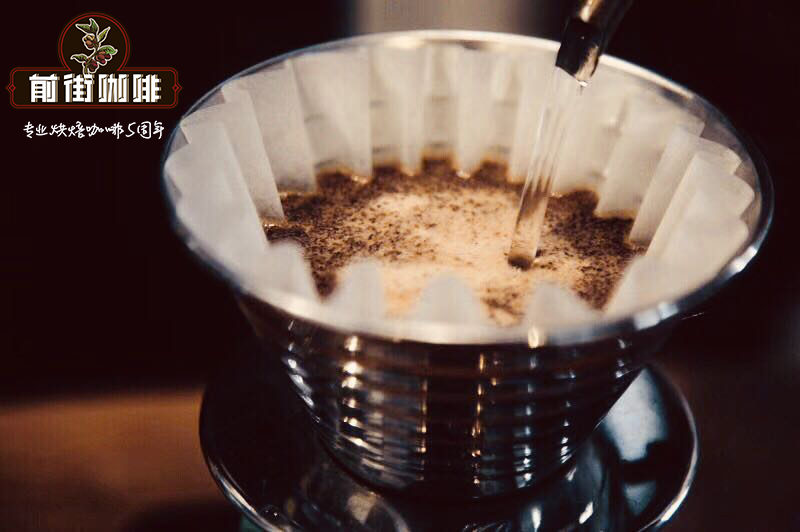Modern hand-brewing coffee comes from a housewife telling you what hand-brewing coffee is.

Professional coffee knowledge exchange more coffee bean information please follow the coffee workshop (Wechat official account cafe_style)
With the sweeping of the third wave of coffee, boutique coffee has become the mainstream of the global coffee industry, and nothing shines more brightly than hand-brewed coffee. In addition to the emergence of a large number of coffee shops specializing in hand-brewing coffee, hand-brewing is very sensitive to personal feelings, so it has also blown a wave of personalization, and even in social media, the community that belongs to hand-brewing has gradually taken shape.
So, you who love hand flushing, do you know the history of hand flushing?
It can be said that the main source of Taiwan's understanding of fine coffee is Japan, so many people mistakenly think that hand-brewed coffee was invented in Japan. In fact, the modern hand brewing method comes from an unexpected country-Germany, and the filter cup used in this brewing method is invented by a woman who is called a legend in the European coffee industry, because she has gone from an ordinary housewife to the chairman of a company.
Since coffee was introduced into Europe from Arabia, the traditional way of making coffee in Europe is to use linen or metal strainer to filter out the coffee grounds. However, if you use linen cloth, wash it very clean every time you use it, otherwise it will stink. If the use of metal filter, it is limited to the level of technology at that time, can not make enough small pores, so it will let a lot of coffee grounds through the filter.
The modern common technology of using filter paper to filter coffee powder was invented by a German housewife Melitta Bentz in the early 20th century and patented in 1908 and has been in use ever since.
Mrs. Merita, then 35, loved coffee very much, but she thought the traditional way of making coffee was very troublesome, so she always hoped to invent a more convenient and easy way to make coffee. When she was worried about this, she happened to see her son's school workbook. In a flash of inspiration, she used the ink paper of the workbook to make the world's first coffee filter paper.
The texture of the filter paper made of ink paper is quite light and thin, and compared with linen, it is cheap, discarded after use, and has less trouble of cleaning. The function of the filter residue is even more excellent. Compared with the metal filter, after the coffee grounds are brewed with less coffee grounds, not only the strange taste of the coffee grounds in the mouth disappears, but also the bitterness and astringency are reduced, and the coffee produced is more palatable than ever. In addition, Mrs. Melita also created a hand-punched ceramic filter cup.
Melita's friends were shocked by the wonderful taste of her hand-brewed coffee, and some suggested that she should start her own business and sell filter paper and cups. The proposal was very attractive to Mrs. Merita, but it was also difficult to choose because it was very special in Germany at the time, and the traditional view was that a housewife should take good care of the house rather than start a company.
Mrs. Merita has the characteristics of a typical German woman-resolute, independent, and strong. As a young woman, she doesn't want the words "housewife" written on her tomb inscription after death. She doesn't want her life to be like this ordinary past. As a result, Mrs. The Melitta Company patented her filter paper and cup in 1908 and founded Merita in the same year.
Surprisingly, under the unfavorable and accidental situation, Mrs. Merita may have made the company quite good because her family has always had experience in starting a business and running a business. not only through word-of-mouth marketing to expand a large customer base, hand-made coffee utensils are constantly innovating, launching a series of new products in 1920 and 1930s.
As the products launched by the company sell well all over Europe, the handmade coffee invented by Mrs. Merita is also popular all over the world. This has established Mrs. Melita's status as a "godmother" in the coffee industry, and must have envied many people for her successful experience of starting a business for the first time.
The Melitta Company ran the company as a family business and remained chairman of the company until her death in 1950, and as hand fans know, Melita is still the leading brand in the European hand punch industry.
However, with the gradual popularity of Italian coffee machines and the rise of Starbucks, which represents coffee commercialization and American fast culture in the 1980s and 1990s, hand-brewed coffee, which emphasizes "slow", has gradually declined in Europe and the United States. Until the past 10 years, with the third wave of coffee, hand-brewed coffee has sprung up again in Japan.
Today's hand-brewed coffee can be said to be combined with the Japanese "Zen way" and "tea ceremony", emphasizing self-exploration and enjoyment in the brewing process, and carried forward by teacher Taguchi, and then gradually introduced into Taiwan.
In fact, there has been a gradual revival of hand-brewed coffee in Europe and the United States in the past few years. Coffee originated in Ethiopia and was introduced into Europe by Arab merchants until modern times. The Italian invented the Italian coffee machine, the Americans used Starbucks to conquer the world, and the hand brewing was invented by Germany. But it is gradually declining and now combined with the traditional culture of Asia, it has been transmitted back to Europe and the United States by Japan. Coffee has always been the crystallization of the fusion and conflict between the East and the West.
Important Notice :
前街咖啡 FrontStreet Coffee has moved to new addredd:
FrontStreet Coffee Address: 315,Donghua East Road,GuangZhou
Tel:020 38364473
- Prev

4 the skill of making coffee with big hands, making coffee by yourself can make people and gods indignant.
Professional coffee knowledge exchange more coffee bean information please follow the coffee workshop (Wechat official account cafe_style) Taiwanese love to drink coffee, but also like to brew their own coffee, the rise of hand-brewed coffee has led to a trend of brewing their own coffee, and even utensils are constantly innovating, giving coffee fans more choices; hand-brewed coffee classrooms or coffee clubs have also been set up one by one, which can be seen
- Next

Hand brewing coffee utensils recommend what is hand brewing coffee
Professional coffee knowledge exchange more coffee bean information Please pay attention to the coffee workshop (Wechat official account cafe_style) temperature is everything that determines the taste of coffee, immersed in the comfortable spring afternoon sun, enjoy afternoon tea, thinking of what this temperature has brought to me. I like the taste of African beans, the sweetness of Tanzania, the aroma of Esopia, the balance of Congo, especially the original.
Related
- Beginners will see the "Coffee pull flower" guide!
- What is the difference between ice blog purified milk and ordinary milk coffee?
- Why is the Philippines the largest producer of crops in Liberia?
- For coffee extraction, should the fine powder be retained?
- How does extracted espresso fill pressed powder? How much strength does it take to press the powder?
- How to make jasmine cold extract coffee? Is the jasmine + latte good?
- Will this little toy really make the coffee taste better? How does Lily Drip affect coffee extraction?
- Will the action of slapping the filter cup also affect coffee extraction?
- What's the difference between powder-to-water ratio and powder-to-liquid ratio?
- What is the Ethiopian local species? What does it have to do with Heirloom native species?

